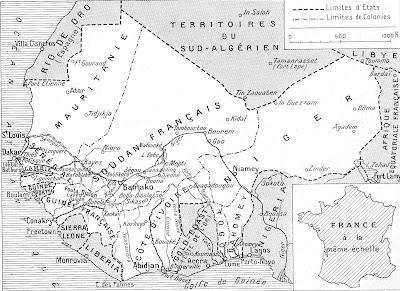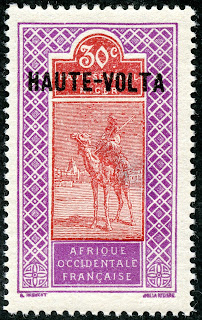1920 Scott 19 45c blue & brown "Camel with Rider"
Red Overprint; Stamps and Types Upper Senegal and Niger, 1914-17
Quick HistoryUpper Volta (Haute-Volta) has had an exist/ doesn't exist/exist history, but the classical era saw Upper Volta adjacent and north of the British Gold Coast carved out from a southern section of Upper Senegal and Niger to form a separate colony on March 1, 1919 within French West Africa.
Stamps were released in 1920 using the overprinted Upper Senegal and Niger 1914-17 issue and types.
Population was approximately 3,000,000.
Upper Volta (green); French West Africa (lime green)
The colony lasted until September 5, 1932, when, in an economic move, the colony was divided among its neighbors- French Sudan, Ivory Coast, and Niger Territory.
French West Africa circa 1936
Note "Upper Volta" has disappeared
Upper Volta stamps were discontinued on January 1, 1933.
Mossi Kingdom circa 1530
The area of the Upper Volta river and surrounding savanna was dominated by the Mossi Kingdoms from the 13th century until 1896, when the French captured their capital of Ouagadougou.
Mossi Horsemen 1890
The Mossi were a formidable group, both as farmers (millet, sorghum), and soldiers. They were able to resist some of the inroads (not all) of both Christianity and Islam, while looking to their ancestors for spiritual guidance. Little wonder that the French left the Mossi chief /village administration substantially intact. Their language, Moore, is still spoken by the majority of the population today.
Reconstituted Upper Volta
After WW II, the Mossi were successful in having the French reestablish Upper Volta as a separate French West African territory on September 4, 1947.
Upper Volta became independent on August 5, 1960.
On August 4, 1984, the name was changed to Burkina Faso, meaning "the country of honorable people".
1922 Scott 29 0.01c on 15c, Black Surcharge
On 1920 Scott 9 15c chocolate and orange
Issue Surcharged in Various Colors
Into the Deep BlueThe 2014 Scott Classic Specialized 1840-1940 catalogue has, for Upper Volta 1920-1931, 89 major descriptive numbers. Of those, 58 are CV <$1-$1+, or 65%. Clearly, the WW collector should be able to form a representative collection without too much expense.
The 1920-28 issue uses overprinted 1914-17 Upper Senegal and Niger stamps. Some were issued in a change of color (color types).
Upper Volta had its own issue proper in 1928.
A closer look at the stamps and issues
100 Centimes = 1 Franc
1925 Scott 15 30c violet & brown red
Black Overprint; "Camel with Rider"
Stamps and Types Upper Senegal and Niger, 1914-17
We have come across the "Camel with Rider" design before, as it was used by Upper Senegal and Niger 1914-17. With the advent of "Upper Volta", having been given colony status in 1919 from a former portion of Upper Senegal and Niger, this issue was overprinted "Haute- Volta". Between 1920-28, twenty-eight stamps, many of them color "types", were released.
1925 Scott 22 50c red orange & blue
Black Overprint; "Camel with Rider"
Stamps and Types Upper Senegal and Niger, 1914-17
Finding used examples for the colony can be done, but it is not common. My collection consists of 90% unused.
CV is <$1-$1+ for 24 stamps. Perhaps reflecting the lack in collections of genuine "used", CV is modestly higher for that state.
CV is <$1-$1+ for 24 stamps. Perhaps reflecting the lack in collections of genuine "used", CV is modestly higher for that state.
1922 Scott 31 0.05c on 15c, Red Surcharge
On 1920 Scott 9 15c chocolate and orange
Issue Surcharged in Various Colors
In 1922, the 15c chocolate and orange was surcharged in three colors (black, blue, red), creating a three stamp issue.
The 1922 surcharged stamp issue in various colors can be found for other French colonies as well, such as Senegal.
The 1922 surcharged stamp issue in various colors can be found for other French colonies as well, such as Senegal.
1922 Scott 32 60c on 75c violet/pinkish
Type of 1920 Surcharged
The 1922 60c on 75c, with bars over the former value, is similar to other 1922 French colony surcharged stamps, such as found for the Ivory Coast.
1924 Scott 34 25c on 5fr violet & black
Stamps and Types of 1920 Surcharged
With New Value and Bars
Between 1924-27, ten stamps were surcharged as shown.
CV is <$1-$1+ for six stamps.
CV is <$1-$1+ for six stamps.
1928 Scott 43 1c indigo & green
"Hausa Chief"
The colony issued a new set with three designs ("Hausa Chief", "Hausa Woman", "Hausa Warrior") in 1928.
The twenty-three stamp set is CV <41-$2+ for seventeen stamps.
The twenty-three stamp set is CV <41-$2+ for seventeen stamps.
1928 Scott 47 10c indigo & pink
"Hausa Chief"
The Hausa people are one of the largest ethnic groups in Africa (50 million), but, as important, the Hausa language developed into the lingua franca across Western Africa for trade. They are centered in Nigeria and Niger.
The twenty million nomadic Islamic Fulani (Peul) are found, in part, in northern Upper Volta. They often used the Hausa language for trade. In many cases, the Hausa and Fulani people have absorbed parts of each other's culture. But, I believe the portraits in this stamp set are actually Fulani, rather than Hausa, if the native images purport to be from Upper Volta.
The twenty million nomadic Islamic Fulani (Peul) are found, in part, in northern Upper Volta. They often used the Hausa language for trade. In many cases, the Hausa and Fulani people have absorbed parts of each other's culture. But, I believe the portraits in this stamp set are actually Fulani, rather than Hausa, if the native images purport to be from Upper Volta.
Ethnic Groups West Africa
Specifically, the "Mossi" people and language is 40% of the population of Upper Volta (part of Central Bantoid group (purple)).
The Mande ethnic group (pink) inhabits part of western Upper Volta, while the Fulani group is located in the north.
1920 Scott J2 10c rose
Postage Due Stamps of Upper Senegal and Niger, 1914,
Overprinted in Black or Red
The 1920 postage due set of eight stamps are overprinted in black or red on 1914 Upper Senegal and Niger stamps.
CV is <$1-$1+ for all eight stamps.
CV is <$1-$1+ for all eight stamps.
1928 Scott J11 5c green
The Upper Volta postage due set proper was released in 1928 on ten stamps.
CV is <$1-$6+ for eight stamps.
CV is <$1-$6+ for eight stamps.
Deep Blue
1920-28 Issue in Deep Blue
Deep Blue (Steiner) has six pages for the 1920-1931 issues of Upper Volta. All of the major Scott numbers have a space.
1924 Scott 33 25c on 2fr green & blue
Stamps and Types of 1920 Surcharged
With New Value and Bars
Big Blue
Big Blue '69, on four pages, has 75 spaces for the stamps of Upper Volta.
Coverage is a generous 84%.
There are two "expensive" (CV $10+) stamp spaces for the 1928 postage due issue.
Checklist
1920
1,2,3,4,6,9,
10,17,18,19,25,26,
1922
5,7,12,14,21,32,
1922
29,30,31,
1924
33,34,
1925
35,36,8,15,22,23,
Next Page
1926
38,
1927-28
37,39,16,14,
1928
43,44,45,46,
47,48,49,50,51,52,
53,54,55,56,57,
58,59,60,61,
Next Page
1931
66,
67,68,
69,
Next Page
Postage Due
1920
J1,J2,J3,
J4,J5,J6,J7,J8,
1928
J11,J12,J13,J14,J15,J16,J17,
J18,J19,J20,
Comments
A) Expensive stamps ($10 threshold):
1928 Scott J19 2fr lilac rose ($10+)
1928 Scott J20 3fr orange brown ($10+)
1920 Scott J1 5c green
Postage Due Stamps of Upper Senegal and Niger, 1914,
Overprinted in Black or Red
Out of the Blue
Unraveling the 1928 "Hausa" set- which actually portray "Fulani" - resulted in a three hour pleasant diversion. One never knows where stamps will take you. ;-)
Note: Maps and Mossi Horsemen image appear to be in the public domain.
Have a comment?




















I noted the Hausa being a curious choice of subject when working on the Upper Volta profile for SWH. Interesting you dug into that some more. Question: why do you think the stamps, if not Hausa, portray the Fulani rather than the Mossi, the dominant population group in Upper Volta?
ReplyDeleteGood question. It could be the Mossi. But why wouldn't the French simply label it "Mossi" then? The Hausa and Fulani share language characteristics ( the Fulani used the Hausa language for trade), and it seemed to me that the two groups tended to get confused in documents, and the Fulani ( which are nomadic) are found on the map in the far north. But it is an educated guess.
Delete